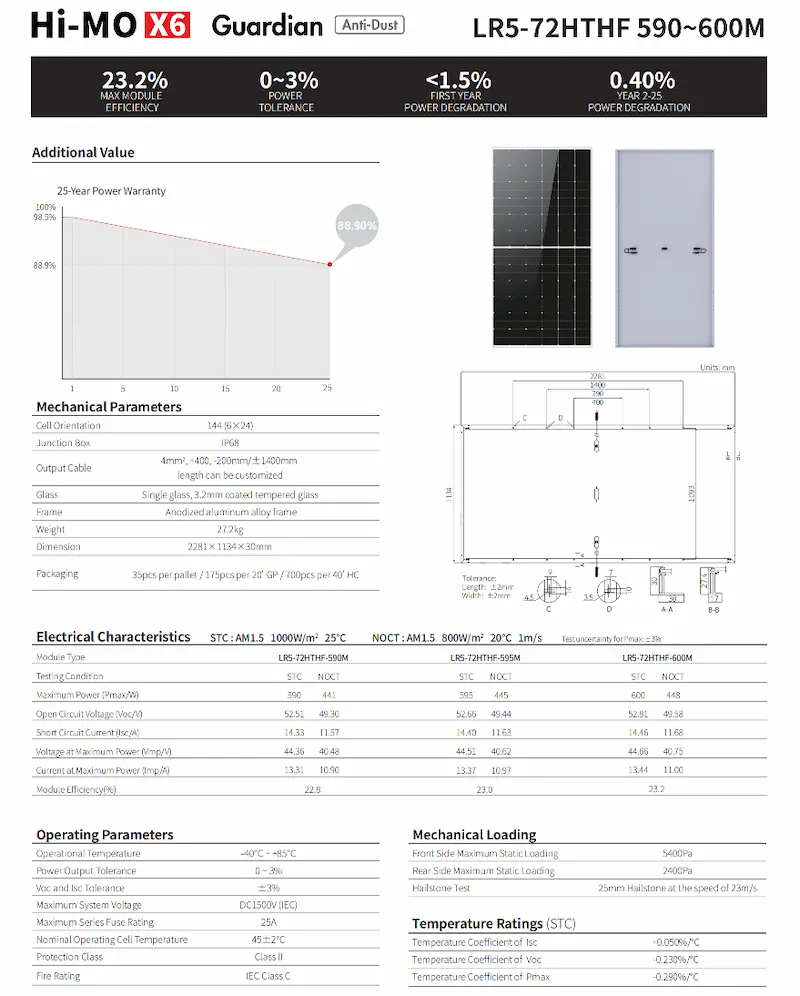Product characteristics:
- Equipped with HPBC Cell, continuing the high efficiency gene
- Unique border design effectively reduces the impact of dust accumulation and improves power generation gain throughout the entire lifecycle
- High reliability, stable operation under harsh testing conditions
- More suitable for industrial and commercial colored steel tile roofs and small angle installation scenarios
The solar cell product is designed with cutting-edge HPBC (Hybrid Passivated Back Contact) technology, ensuring high efficiency and excellent performance. Its unique border design effectively reduces the impact of dust accumulation, leading to improved power generation gain throughout the entire lifecycle of the solar cell. With high reliability and stable operation even under harsh testing conditions, this product is particularly well-suited for industrial and commercial applications, especially on colored steel tile roofs and in scenarios requiring small angle installations.
A solar cell product refers to a physical device designed to convert sunlight directly into electricity through the photovoltaic effect. It typically consists of multiple solar cells interconnected to form a solar panel or module. Here are the key components and aspects that make up a solar cell product:
- Solar Cells: These are the fundamental units that convert sunlight into electricity. They are typically made from semiconductor materials, most commonly crystalline silicon. Each solar cell generates a small amount of electrical current when exposed to sunlight.
- Solar Panel/Module: Solar cells are interconnected and encapsulated within a protective casing to form a solar panel or module. This assembly not only protects the cells from environmental factors but also enhances their efficiency by capturing and directing sunlight onto the cells.
- Frame: Many solar panels are housed in a frame, usually made of aluminum, which provides structural support and allows for easy mounting on rooftops or other structures.
- Glass or Encapsulation: Solar panels are covered with a layer of tempered glass or another transparent material to protect the cells from weather conditions and impact. This layer also enhances light transmission to the cells.
- Backsheet: The backsheet is a layer on the rear side of the solar module that protects the cells from moisture and mechanical damage. It also provides electrical insulation.
- Junction Box: This is an integral part of the solar panel where the interconnections between solar cells are made. It houses electrical components such as diodes and connectors, facilitating the output of DC electricity generated by the cells.
- Connectors and Cables: These components enable the solar panel to be connected to other panels, inverters, and the electrical grid or battery storage system.
- Inverter (optional): In residential and commercial installations, an inverter may be included to convert the direct current (DC) generated by the solar cells into alternating current (AC) suitable for use in household appliances or for feeding into the electrical grid.
- Mounting System: This includes the hardware and brackets used to securely install solar panels on rooftops, ground mounts, or other structures, ensuring they are positioned optimally to receive sunlight.
- Performance and Warranty: Solar cell products come with specifications regarding their efficiency, power output, temperature coefficient, durability, and expected lifespan. Manufacturers typically provide warranties that cover performance and product defects over a specified period.
Solar cell products are designed to harness renewable solar energy efficiently and reliably, making them a key technology in the transition towards clean and sustainable energy sources. They are used in a wide range of applications, from residential rooftops to large-scale solar farms, contributing to reducin
After-sales service:
- 15-year Warranty for Materials and Processing
- 25-year Warranty for Extra Linear Power Output







